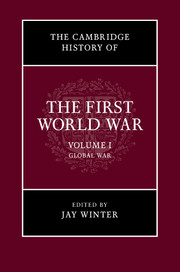
- Cited by 6
-
Cited byCrossref Citations
This Book has been cited by the following publications. This list is generated based on data provided by Crossref.
Edmond, Jennifer Bulatovic, Natasa and O'Connor, Alexander 2015. The Taste of “Data Soup” and the Creation of a Pipeline for Transnational Historical Research. Journal of the Japanese Association for Digital Humanities, Vol. 1, Issue. 1, p. 107.
Calvini-Lefebvre, Marc 2015. The Great War in the History of British Feminism: Debates and Controversies, 1914 to the Present. Revue française de civilisation britannique, Vol. 20, Issue. 1,
Thébaud, Françoise 2015. Understanding twentieth-century wars through women and gender: forty years of historiography. Clio,
2016. Finances publiques en temps de guerre, 1914-1918. p. 249.
2017. La langue sous le feu. p. 243.
2018. Une fiscalité de guerre ?. p. 307.
- Publisher:
- Cambridge University Press
- Online publication date:
- December 2013
- Print publication year:
- 2014
- Online ISBN:
- 9780511675669


